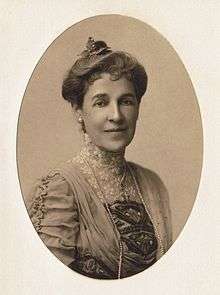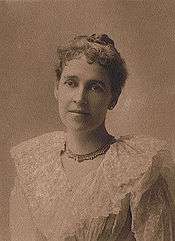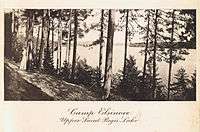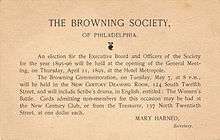Florence Van Leer Earle Coates
Florence Van Leer Earle Nicholson Coates (July 1, 1850 – April 6, 1927) was an American poet.
Florence Van Leer Earle Coates | |
|---|---|
 Florence Van Leer Earle Coates, pre-1916 | |
| Born | Florence Van Leer Earle July 1, 1850 Philadelphia, Pennsylvania, U.S. |
| Died | April 6, 1927 (aged 76) Hahnemann Hospital, Philadelphia, Pennsylvania, U.S. |
| Occupation |
|
| Spouse |
|
| Relatives |
|
| Signature | |
Biography
Coates was born in Philadelphia, Pennsylvania, as the granddaughter of noted abolitionist and philanthropist Thomas Earle, and American Revolutionary War officer Samuel Van Leer, and the eldest daughter of Philadelphia lawyer George Hussey Earle Sr. and Mrs. Frances ("Fanny") Van Leer Earle.[1][2] She gained fame both at home and abroad for her works of poetry—nearly three-hundred of which were published in literary magazines such as the Atlantic Monthly, Scribner's Magazine, The Literary Digest, Lippincott's, The Century Magazine, and Harper's. Many of her poems were set to music by composers such as Amy Beach (Amy Cheney Beach), Clayton Johns, and Charles Gilbert Spross. She attended school in New England under the instruction of abolitionist and teacher Theodore Dwight Weld, and would further her education abroad at the Convent of the Sacred Heart in Paris (Rue de Varenne),[3] and by studying music in Brussels under noted instructors of the day.

.jpg)
"My remembrance of our last visit and of your tulip-trees and maples I shall never lose ..." —Matthew Arnold, in a letter to Coates[4]
Literary and social critic Matthew Arnold both encouraged and inspired Coates's writing of poetry. He was a guest at the Coates' Germantown home when his lecture tours brought him to Philadelphia. Coates and Arnold first met in New York—during Arnold's first visit and lecture tour of America—at the home of Andrew Carnegie, "where they formed a lasting friendship".[5] The tour (which lasted from October 1883 to March 1884) brought Arnold to Philadelphia in December 1883, where he lectured at Association Hall on the topics of the "Doctrine of the Remnant" and on "Emerson".[6] His second visit and tour of America took place in 1886, and brought him to Philadelphia in early June where he was again hosted by the Coates and spoke on the topic of "Foreign Education" at the University of Pennsylvania chapel.[7] Arnold wrote to Coates in 1887[8] and 1888[9] from his home at Pains Hill Cottage in Cobham, Surrey, England describing his remembrance of and fondness for her "tulip-trees and maples" at her Germantown home, "Willing Terrace". Rarely did Coates write or publish prose work, but in April 1894 and again in December 1909, she dedicated her pen to remembrances of her mentor in issues of The Century and Lippincott's magazines respectively.
Between 1887 and 1912, Coates published over two dozen poems within The Century Magazine. Her correspondence between Century editor Richard Watson Gilder and others is documented at the New York Public Library Digital Collections website.[10] In one letter dated March 12, 1905, Coates submitted to Mr. Gilder a poem she wrote after being inspired by a photograph of Helen Keller holding a rose which was published in The Century the previous January. Coates requested that, if published, the poem also be accompanied by a copy of the photograph, and shared that Ms. Keller sent word that she "accord[ed] [Coates] any permission" to use the photo for that purpose. The poem, "Helen Keller with a Rose", was published in the July 1905 issue—without the accompanying photograph, but with reference to the issue in which it first appeared.
The Coates often spent their summer months in the Adirondacks, where they maintained "Camp Elsinore"—their summer camp by the Upper St. Regis Lake. It was there that they entertained, rested and escaped the humidity of Philadelphia summers, welcoming friends such as Otis Skinner, Violet Oakley, Henry Mills Alden, and Agnes Repplier.[11] In the early 1900s, the Coates seasonally opened their camp to Anna Roosevelt Cowles ("Bamie")—the elder sister of Theodore Roosevelt. Among Cowles's visitors during her stays at Elsinore was Alice Roosevelt, President Theodore Roosevelt's daughter.[12] Many of Coates's nature poems were inspired by the flora and fauna of the Adirondacks. Of her "spot in the mountains", Coates sings:
There's a cabin in the mountains, where the fare, dear,
Is frugal as the cheer of Arden blest;
But contentment sweet and fellowship are there, dear,
And Love, that makes the feast he honors—best!

There's a lake upon
the mountains...—FEC
In the March 1913 issue of Lippincott's Monthly Magazine, noted anthologist and poet, William Stanley Braithwaite (1878–1962), gives a detailed nine-page review of Coates's poetry, relating how "she draws from the Olympian world figures that typify some motive or desire in human conduct, and in the modern world the praise of men and women, heroic in attainment or sacrifice; or laments events that effect social and ethical progress, showing how beneficently she has brought her art, without modifying in the least its abstract function as a creator of beauty and pleasure, into the service of profound and vital problems".[13] Much of Coates's later published work was written during the years spanning World War I and showcased her concern for such "profound and vital problems" as her voice joined the chorus of "singers" in support of American involvement in the war—evidenced in her privately published pamphlet of war poetry, Pro Patria (1917). Coates also penned several other works of fugitive verse, much of which is patriotic and war-related, describing the selfless sacrifices made by soldiers and citizens alike for the cause of freedom and liberty.

Coates was a founder of the Contemporary Club of Philadelphia in 1886; one of twenty founders of the Society of Mayflower Descendants in the Commonwealth of Pennsylvania[14] in 1896—herself being a ninth generation descendant of Pilgrim John Howland;[15] and twice president of the Browning Society of Philadelphia from 1895 to 1903, and again from 1907 to 1908. In 1915, Coates was unanimously elected poet laureate of Pennsylvania by the state's Federation of Women's Clubs.[16]
Coates married William Nicholson in 1872. He died in 1877. On January 7, 1879, she married Edward Hornor Coates at Christ Church in Philadelphia. Edward Coates would eventually adopt Florence's daughter from her first marriage—Alice Earle Nicholson (born October 21, 1873). Florence and Edward had one child together in 1881, but the baby—Josephine Wisner Coates[17]—died in infancy on March 5, 1881. Edward Coates was president of the Pennsylvania Academy of the Fine Arts from 1890 to 1906. He died on December 23, 1921. In 1923, Florence Coates presented The Edward H. Coates Memorial Collection to the Pennsylvania Academy of the Fine Arts in Philadelphia. The exhibition, representing French and American schools,[18] included 27 paintings and 3 pieces of sculpture, and was displayed from November 4, 1923 to January 10, 1924.
Coates died at Hahnemann Hospital in Philadelphia on April 6, 1927. She is buried at the Church of the Redeemer churchyard in Bryn Mawr, Pennsylvania alongside her husband and her brother George Howard Earle, Jr. and many of his descendants, including his son, former Pennsylvania Governor, George Howard Earle III—Florence's nephew.[19]
List of works
Gallery
 A platinum print photograph of Coates
A platinum print photograph of Coates.jpg) Edward Hornor Coates (1903) by Charles Grafly at the Pennsylvania Academy of the Fine Arts
Edward Hornor Coates (1903) by Charles Grafly at the Pennsylvania Academy of the Fine Arts Digital drawing of the headstones of Coates and husband in Pennsylvania
Digital drawing of the headstones of Coates and husband in Pennsylvania Hymn written for the Society of Mayflower Descendants in the Commonwealth of Pennsylvania (1900)
Hymn written for the Society of Mayflower Descendants in the Commonwealth of Pennsylvania (1900)
References
- "American Poet Florence Van Leer Earle".
- "Van Leer Papers".
- The Sacré Cœur (Sacred Heart) in Paris, France was a convent school for young girls run by nuns that fell to the French government as a result of the "religious orders" law of 1904, which involved the separation of church and state, and prohibited religious orders from teaching. The site of the former convent is now the Rodin Museum.
- Letter from Matthew Arnold to Florence Van Leer Earle Coates dated 24 February 1888.
- Notable Women of Pennsylvania (1947), edited by Gertrude B. Biddle and Sarah D. Lowrie.
- "Matthew Arnold on the Doctrine of the Remnant." Philadelphia Inquirer, December 28, 1883.
- "Reception to Matthew Arnold." Philadelphia Inquirer, June 11, 1886.
- Letter from Matthew Arnold to Florence Van Leer Earle Coates dated 29 January 1887.
- Letter from Matthew Arnold to Florence Van Leer Earle Coates dated 24 February 1888.
- Manuscripts and Archives Division, The New York Public Library. "Coates, Florence Van Leer Earle" The New York Public Library Digital Collections. 1886 – 1914. https://digitalcollections.nypl.org/items/ab8d1c90-6238-0134-2dec-00505686a51c
- "Florence Earle Coates: Some Phases of Her Life and Poetry" by Elizabeth Clendenning Ring. Book News Monthly (December 1917)
- New York Times, June 28, July 19 & 26, and August 30, 1903. Cowles's stays are also mentioned (along with a photograph) in Lilian Rixey's biographical book, Bamie: Theodore Roosevelt's Remarkable Sister.
- A Foremost American Lyrist: An Appreciation by William Stanley Braithwaite
- The Society of Mayflower Descendants in the Commonwealth of Pennsylvania (SMDPA)
- "Register of Members" (Philadelphia: Society of Mayflower Descendants in the Commonwealth of Pennsylvania) 1996, p. 57.
- Walker, Robert H. "Coates, Florence Earle." Notable American Women: 1607–1950. Cambridge, MA:Belknap Press of the Harvard Univ. Press, 1974:354.
- likely named after Josephine Wisner, great-great granddaughter of Henry Wisner—delegate of the 1st and 2nd Continental Congress and among signers of the original draft of the Declaration of Independence. Josephine Wisner's mother, Eleanor Bowne Hornor, was Edward Coates's second cousin.
- Philadelphia: A Guide to the Nation's Birthplace. Pennsylvania Historical Commission, 1937. p. 456.
- The Lower Merion Historical Society website (see Coates, Florence Earle).
- Historically listed and referenced as a "Collected edition," Robert H. Walker—in his biographical sketch of Coates ("Coates, Florence Van Leer Earle Nicholson." Notable American women: a biographical dictionary (1971, 1974 (third printing); pp. 353–4)—notes that the two-volume set is "really selected."
External links


- Florence Earle Coates informational blog
- Works by or about Florence Van Leer Earle Coates at Internet Archive
- Works by Florence Van Leer Earle Coates at LibriVox (public domain audiobooks)

- Florence Van Leer Earle Coates at Find a Grave
